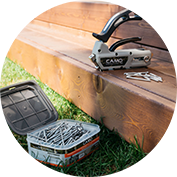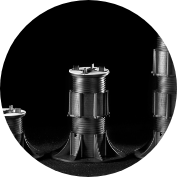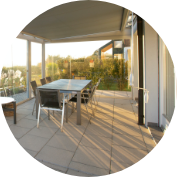Tips for taking care of your terrace in spring

The rebirth of nature in spring is like a call to remember that it’s time to revitalise your home too. One of the areas of the home that we often forget is the terrace. Autumn leaf debris, melted snow, other precipitation from the cold season and dust leave traces on the terrace. Let’s take a look at how to properly care for a wooden, WPC wood plastic composite or tile terrace in spring and prepare it for the warm season.
Terrace maintenance in spring is not a complicated process and often consists of two or three steps: cleaning the terrace, sanding where appropriate, and treating it with a special protection product. Depending on the material, different maintenance and conservation measures are applied to patio coverings, so it is important to know how to take good care of a particular type of patio in spring.
Wooden terrace – basic maintenance steps
The first step
No matter what the material of your terrace floor, the first step is always the same: removing the dirt that has accumulated over the winter. The first step is dry cleaning, sweeping the terrace floor. Afterwards, the floor is thoroughly rinsed with water using a brush or a high-pressure washer, at a low pressure setting, and kept away from the floor while washing to avoid scratching the wood, in order to finally remove the dirt accumulation.

If your terrace floor is made of wood, the cleaning process is made much easier and more effective with the specially developed WocaExteriorWoodCleanerfrom Danish brand WOCA.
This environmentally friendly detergent acts as a soap and is used for periodic maintenance and for preparing the oiling of the terrace after winter. It not only washes away dirt, removes mould and opens the pores of the wood, but also increases oil absorption. In this way, the oiled terrace will last much longer. If the terrace is discoloured, has deep stains or it is not known which oil has been used before, it is advisable to use the stronger Woca Deep Cleaner.
Follow these steps to properly clean your terrace in spring with Woca Exterior Wood Cleaner:
1. Dampen the patio boards or other wood surface with water.
2. Add the correct amount of wood cleaner to the container with water.
3. When washing the wooden terrace after winter and preparing it for oiling, the product should be diluted 1:3 or 1:2 (20-30 m2).
4. Dip the scrubbing tool (sponge with handle or brush) into the prepared detergent and apply to the wood surface.
5. Scrub the terrace boards with a scrubbing tool moistened with detergent.
6. Rinse the surface thoroughly with water, completely removing the cleaning agent.
7. Leave the cleaned surface to dry for at least 48 hours.
Step two
If your aim when caring for your wooden terrace in spring is not only to wash away the dirt from the cold season, but also to properly prepare the wooden planks for oiling, then the next step would be sanding. However, it is not essential, only recommended. The boards can be lightly sanded for perfect smoothness. This will help remove old oil residues, sharp chips and bumps. It is recommended to use 100-120 grit sandpaper when sanding wood fibre.
Step Three
Once the wooden terrace has been properly washed and treated, it’s time to oil it. Oiling is a great way to give your wooden terrace not only protection but also the right look.
Oiling a wooden terrace starts with the choice of oil. The choice of this wood care product is based not only on the colour range offered, but also on other important features such as ease of use, simple technology, eco-friendliness, high quality, water resistance and reliability of protection.
The professionals at MDS Terasos recommend the Danish brand WOCA wood surface oil, which meets the highest quality requirements and satisfies the needs of the most demanding consumers worldwide. There are as many as 13 colours to choose from.
WOCA Exterior Wood Oil
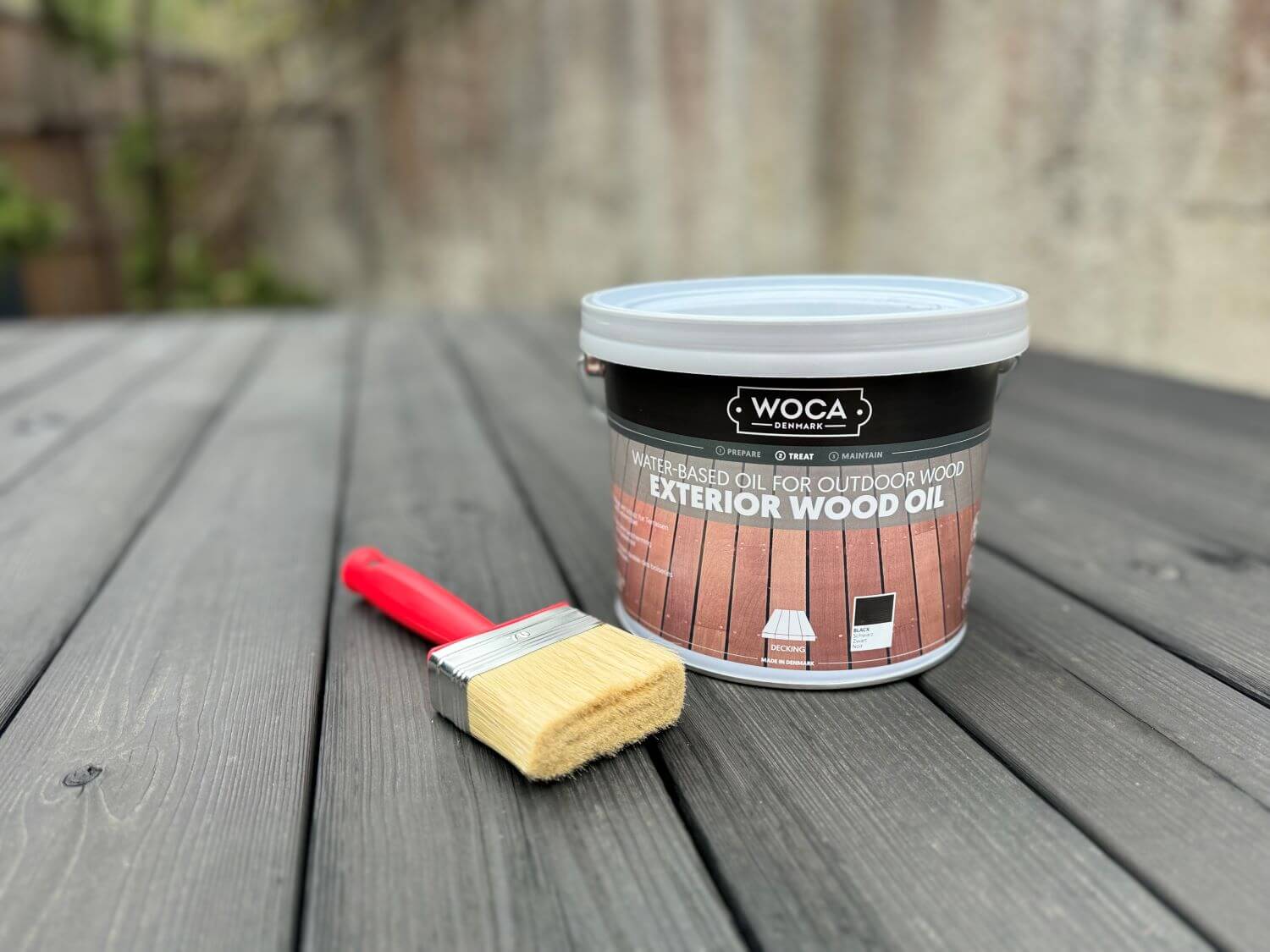
WOCA oil provides excellent protection of the wood surface – making it resistant to external contamination. It is environmentally friendly and water-based. Suitable for the maintenance of terraces, facades, outdoor furniture and other wooden surfaces. This oil provides strong protection against water and dirt, has an antiseptic effect – it prevents the growth of mould or fungus, and enhances the wood’s natural colour and texture. It also protects against UV damage, drying out and cracking. This oil dries quickly, making it convenient and easy to use. It is also cost-effective – just one coat of oil is enough for complete protection of the terrace. WOCA oil is suitable for impregnated and thermoplastic pine, larch and hardwood boards.
A wooden terrace can be oiled with a colourless oil or an oil with different colour pigments. When using a coloured oil with UV protection, the final result will depend on the type of wood and the number of coats applied. The same shade of oil will look different on pine, larch, exotic wood or thermo-wood planks. So if it is important to get a particular shade of patio boards, it is advisable to try out oil samples in different colours first, so that you can choose the most suitable one from the wide range of colours.
As with cleaning a terrace, there are certain steps that should be followed in the oiling process.
1. First, prepare the oiler. Choose a quality product that will give your wood the protection it needs.
2. Pay attention to weather conditions and forecasts. The air temperature must be at or above 13 degrees and should remain so for at least 8 hours. after oiling. Also, pay attention to the rainfall forecast, as rain can wash away the oil before it can soak into the board.
3. When the terrace is being poured, tape the underside of the building walls with paper adhesive tape. In this way, you will oil the surface much better, you will not have to clean the walls if you accidentally apply oil.
4. Allow the rinsed wood to dry for at least 24 hours. The moisture content of the wood prepared for liming should not exceed 17%.
5. Choose your working tool – brush, sponge or applicator.
6. Shake the oil can well before oiling.
7. After opening the container of oil, give it another good stir to avoid uneven colour streaks.
8. Olive a board or two, evenly along the entire length, so that there are no uneven colour transitions.
9. Rub the oil well with a cloth and wipe off any excess within 5 minutes.
10. Allow the oil to dry for at least a day to allow it to soak into the pores of the wood.
11. It is important to follow the manufacturer’s instructions when oiling the terrace. It is advisable to move in the direction of the texture of the wood in order to allow the oil to soak into the surface better.
What not to do?
It is important to mention what should not be done when oiling the boards – you should not oil the decking boards when they are damp or in direct heat. As oil affects the structure of the wood, it is important that it is well absorbed into the pores of the wooden boards.
WPC Terrace – highlighting the colour of the boards
WPC terraces are another popular low-maintenance option. These terraces are not only durable but also resistant to environmental influences. In spring, it’s important to take a little care to keep the terrace beautiful and attractive, and if you need to brighten up the colour of the boards, you know how to do it.

The first step in spring is to wash off the dust and dirt that has accumulated on the terrace after winter. This can be done with a broom or a brush, but the best choice would be to use a water-pressure device. This method not only cleans effectively, but also does not damage the surface of the terrace.
The second step is to protect the WPC decking boards from external influences and to renew the colour.
WPC Wood Plastic Composite Terrace Boards are designed to be a long-lasting finish for the terrace, but UV rays and other weather conditions affect the boards, so the brightness of the colours slowly fades. However, there are methods to restore WPC boards to their original appearance and to refresh and brighten their colour. One method is oiling the WPC boards, the other is nano-impregnation.
Oiling
As a lubricant, colourless or coloured WOCA oil is an excellent choice. Although WOCA oil is designed for oiling natural wood terraces, WOCA technologists confirm that WPC boards can also be refurbished perfectly with this oil, following the oiling steps described above. Oiling revitalises the colour of boards that have faded from UV rays, and reduces staining and water absorption.
Impregnation
If colour renewal is not an issue for WPC decking boards and you just want to protect the boards from external influences, you can give them invisible protection by impregnating them. One way to do this is to impregnate it with a nano-coating, which provides invisible protection against moisture, stains and other negative factors.
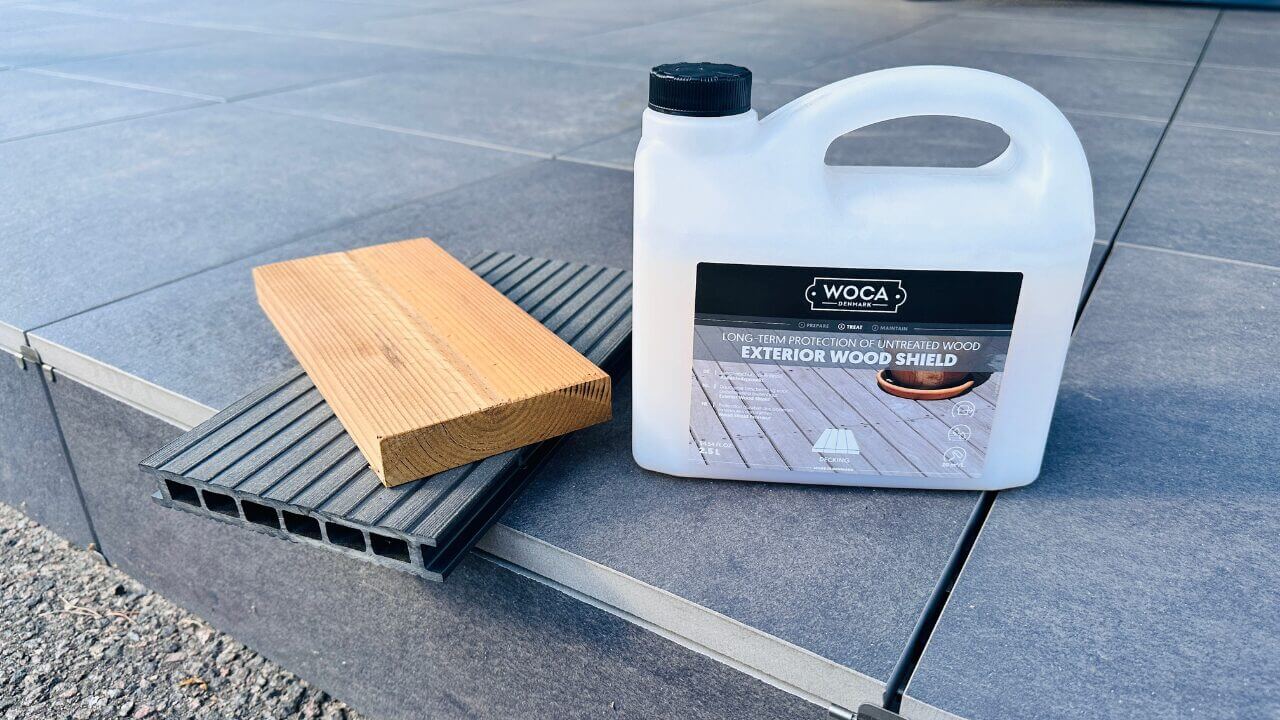
Woca Wood Shield impregnant nano-coating is an effective way to quickly and easily protect wood plastic composite decking boards. It is easy to apply the product yourself, but it is important to follow the manufacturer’s instructions and use the correct tool.
Tile terrace – protection against stains
The spring renovation of a tiled terrace should start with cleaning the accumulated dirt to keep the tiles clean and tidy. This can be done with a broom, brush or water pressure device. It is important to pay attention to the spaces between the tiles, where dirt often accumulates.
After cleaning, Woca Wood Shield nano impregnator can be used to provide additional protection for the stoneware tiles. This product will ensure that the terrace is protected from moisture, grease and other food stains and even microbes.
The Nano Impregnator is easy to use. It can be applied with a brush or spray. It is important to ensure that the product is evenly distributed over the entire surface. After impregnation, the terrace should be allowed to dry and you can enjoy a clean and safe outdoor space.
With spring maintenance, you can enjoy your terrace throughout the warm season, knowing that it is not only beautiful but also properly protected from the elements.





